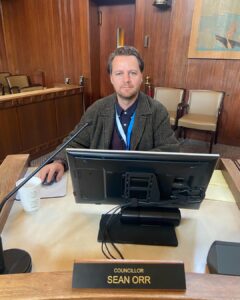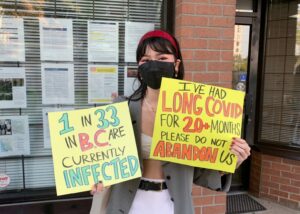By: Cecile Favron, Peak Associate
After Angela Brooks-Wilson became a professor at Simon Fraser University, her family relocated to a neighbourhood just minutes from campus at the base of Burnaby Mountain. It was supposed to be the house that she and her husband would live in for the rest of their careers and into retirement.
“It seemed really perfect until we got a notice from Kinder Morgan,” recounted Brooks-Wilson, a professor in biomedical physiology and kinesiology. “The notice said that they had applied to expand the tank farm.”
That was when the family began to seriously research the safety of the oil-holding Kinder Morgan tank farm, located just a few hundred metres north of their neighbourhood. What they uncovered forced them to reconsider their plans. When Brooks-Wilson recounted her family’s story during a public forum hosted last month at SFU, which discussed links between the tank farm and the prospect of a devastating fire on the mountain, she concluded that the long-term risks they felt prompted them to move.
The potential that a disaster at the neighbouring tank farm might endanger the university campus has also raised alarm among the administration. In 2016, SFU president Andrew Petter said that the risks posed by the tank farm were “significant and deeply concerning” and the university sent a letter to the federal government expressing its objection to the project.
Yet as work gets underway at the Kinder Morgan tank farm, some students and faculty are questioning if the university is doing enough to keep the campus safe.
“President Petter has said the tank farm expansion presents an unacceptable risk to the university, but it is not clear what he is willing or able to do to stop it,” Tim Takaro, an associate dean in the faculty of health sciences, told The Peak in an email interview. “This has not been adequately described to the community nor the media.”
Takaro was the lead organizer of the community-based forum Brooks-Wilson attended. The event was held following a wildfire drill for university personnel earlier in the week to test the new evacuation and shelter-in-place emergency plans.
Despite the recent efforts, many remain concerned that thousands would be put in danger if there were a major fire at the tank farm.
Trapped on the mountain
The Kinder Morgan tank farm borders the intersection of Burnaby Mountain Parkway and Gaglardi Way opposite the entrance to the university. The expansion project, overseen by the subsidiary company Trans Mountain, would double the number of oil storage tanks at the facility, placing the closest tank approximately a kilometer from Convocation Mall, in the centre of campus.
SFU commissioned a report two years ago that found that the expanded tank farm would increase the risk of fire or toxic smoke on or near campus. It also cited a heightened risk that the only evacuation routes from campus would become blocked in the event of an incident at the tank farm, trapping students, faculty, and staff on the mountain.
The concerns echoed a Burnaby Fire Department report released a year earlier which concluded that the tank farm was “not the appropriate location for the expansion.” The report stated that the design for the expanded tank farm, which displayed intent to grow from 13 to 26 storage tanks, could make fires at the facility “inextinguishable due to lack of safe firefighting positions.”
Furthermore, the proposed tanks would be placed closer together and adjacent to the perimeter of the facility, increasing the likelihood that a fire at a single tank would become a multi-tank fire, ignite the surrounding forest, and/or send plumes of toxic smoke into nearby communities.
The expansion project also includes the construction of a second pipeline which would supply heavier crude oils to the tank farm, including bitumen, which is often mixed with natural gas condensate, producing a highly flammable mixture called dilbit.
In the event of an oil spill, the report cited the potential for toxic and flammable vapours to spread beyond the facility and ignite in neighbouring areas after coming into contact with a spark or flame, such as a pilot light.
Additionally, in 2009, Kinder Morgan “failed to notify the community in any matter” about the release of flammable gases when a storage tank was overfilled. The fire department notes that: “The ability or unwillingness to either inform the community or inform City of Burnaby emergency responders does not characterize event management focused on public safety interests as a priority.”
There is also the risk of a rare but devastating event during a tank fire called a boilover, ejecting molten crude oil more than 600 meters, a distance which covers the tank farm, neighbouring communities such as Forest Grove, Meadowood, and Sperling-Duthie, as well as the intersection of Gaglardi Way and Burnaby Mountain Parkway, setting fire to the forest and nearby houses, endangering emergency responders, and blocking off access to SFU.
Kinder Morgan has since attempted to reduce the risk by decreasing the diameter of five of the proposed tanks and increasing the spaces between some of those tanks. A report commissioned by the company last year defined the individual risk as acceptable according to the standards set by the Major Industrial Accidents Council of Canada.
However, the possibility of a catastrophic fire remains. In recent years, there have been major explosions sometimes causing fatal injuries at tank farms in places such as Wisconsin, Washington, Argentina, and the United Kingdom.
In a statement to The Peak, Kinder Morgan subsidiary Trans Mountain said that the company has “detailed emergency response procedures and trained professionals who are prepared to quickly respond to any type of incident anywhere along the pipeline system.”
“It’s also important to note that post-expansion, our Terminals will store the same products, under similar conditions, as we have over the past several years. Trans Mountain has never had a storage tank fire at one of our terminals.”
Preparing for the worst
The university has emphasized that the safety of the campus community is the top priority in regard to the tank farm.
“SFU remains opposed to anything that increases risk to our university community,” said Mark Lalonde, the chief safety officer, in a statement to The Peak. “We continue to advocate our concerns to government and the National Energy Board, and do everything possible to mitigate the risks posed by the tank farm expansion, including pushing for alternative evacuation routes from the Burnaby campus.”
In 2017, shelter-in-place and mass evacuation emergency plans were developed to respond to potential hazards, including those that could arise from the tank farm.
Lalonde was in attendance at the public forum last month to discuss the plans. He informed the audience that the university was overall “very happy” about how the plans held up during the simulation, but added that necessary adjustments were also in progress.
He also responded to audience questions about what would happen if the road to campus was blocked. As previously reported by The Peak, Lalonde noted that the university is only responsible for its property and that the municipality oversees the surrounding roads. Shoulds the roads be blocked in an emergency event, an evacuation may involve the recreational trails going down the mountain.
“[This] is why our plan is shelter-in-place and mass evacuation,” Lalonde said. “That would be the reality is that we’re going to have to stay here, absolute worst-case scenario.”
The City of Burnaby has its own concerns about the challenges of evacuating people from SFU and the adjacent UniverCity neighbourhood. The Peak reached out to Charmaigne Pflugrath, emergency management program coordinator with the city, for comment via email. Pflugrath said that a recent review prompted municipal emergency planners to consider using the trails down the mountain as evacuation routes.
“It is acknowledged that this option will prove challenging, especially for children and persons with disabilities, or for evacuations between dusk and dawn as these trails are unlit,” Pflugrath noted.
Pflugrath added that in the event of an incident where access the the university campus could be compromised she is “confident” first responders “will undertake all activities necessary to protect the road access routes for evacuation purposes in an effort avoid the utilization of the Burnaby Mountain Conservation Area Trail network.”
Trans Mountain would be responsible for the initial response to a fire, or any other emergency, on the tank farm premises and its current emergency plans state that the company would notify SFU. However, evacuation of the surrounding area would fall under the jurisdiction of the city.
SFU must coordinate any efforts to respond to a major emergency situation with outside fire, police, and paramedics. A study by the municipal fire department found that its response times to SFU and UniverCity failed to meet industry standards the vast majority of the time, according to documents obtained by Burnaby Now, leading some to advocate for stationing a permanent fire hall on the mountain.
Lalonde noted that although a scenario where people became trapped on the mountain was unlikely, it is something the university planned for. “This is one of a myriad of concerns I have about the campus here. This is certainly one of the more significant, it has the most catastrophic potential impact,” he concluded.
Calls to action
The numerous challenges associated with responding to an incident on the mountain combined with the increased risk of the expanded tank farm has prompted calls for the university to take action.
Takaro contended that the university is not prepared for worst-case scenarios such as dilbit leaks caused by an earthquake or a large scale wildfire. He added that people on campus need to be more aware of how they should respond in an emergency.
“I don’t think the broader community understand what they will be expected to do in either the mass evacuation nor shelter-in-place responses,” Takaro said.
Jaclyn Parks, a graduate student in health sciences, is also worried that people on campus do not know about the risk of the tank farm or the university emergency procedures. “When people talk about pro- or anti-pipeline they are thinking about a spill along the pipe,” she said, “but not a lot of people have talked about an actual fire.”
“I don’t think the students have any idea that all of this is happening,” she said. “I don’t even have an idea of what happens if there is an alarm . . .”
Takaro called upon the university and the city, both public opponents of the tank farm expansion, to join forces in challenging the expansion project, in addition to undertaking fire risk mitigation measures. At the public forum, he encouraged people to recognize the interconnectedness of climate change, the fire risk, and the tank farm and oppose the pipeline expansion.
“As you now know, we are becoming the owners of Kinder Morgan’s pipeline [now that the Canadian government has bought the pipeline] and it means that our responsibility to stop it is even greater than it has ever been,” Takaro concluded.















[…] stated that the risks to students’ safety posed by the expansion are “unacceptable,” “significant and deeply concerning.” The university later sent a letter to the federal government expressing its objection to the […]